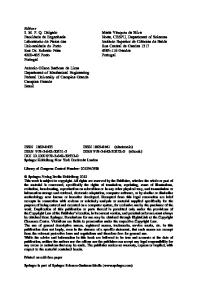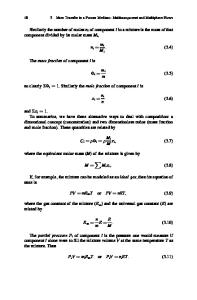Simulating Scale Dependencies on Dispersive Mass Transfer in Porous Media Under Various Boundary Conditions
- PDF / 2,805,235 Bytes
- 19 Pages / 595.276 x 790.866 pts Page_size
- 9 Downloads / 344 Views
RESEARCH PAPER
Simulating Scale Dependencies on Dispersive Mass Transfer in Porous Media Under Various Boundary Conditions N. Natarajan1 · M. Vasudevan2 · G. Suresh Kumar3 Received: 13 June 2018 / Accepted: 19 March 2020 © Shiraz University 2020
Abstract Studies on mass transfer and transport of dissolved contaminants through heterogeneous hydrogeology rely on realistic expressions of their functional parameters. Hydrodynamic dispersion is one such parameter inheriting significant ambiguities in its estimation when subjected to heterogeneous flow conditions. In this study, a numerical model has been developed to explicitly evaluate the variability of dispersion coefficient on time-based and space-based scales for simulating contaminant transport mechanism in saturated porous media under nonlinear sorption mass transfer. Four types of inlet (solute source) conditions, viz., constant continuous, pulsating, exponentially decaying and sinusoidal varying were considered, and the resulting concentration profiles were compared. The governing partial differential equations were solved using an implicit finite difference technique. The results from sensitivity analysis suggest that the magnitude of the fluid velocity was influenced by the type of dispersion coefficient for different inlet boundary conditions. However, sorption partition coefficients and porosities were generally insensitive to the nature of dispersion under these boundary conditions. When time-dependent dispersion coefficient was adopted, an asymptotic increase in retained solute mass was observed for increased fluid velocity irrespective of the boundary conditions. The behavior of the concentration profile obtained using distance-dependent dispersion coefficient was unique when sinusoidal decaying solute boundary condition was used. The study rightly emphasizes the need for simultaneously updating mass transfer and transport parameters while accounting for the variation in solute inlet conditions. Keywords Boundary conditions · Contaminant transport · Dispersion coefficient · Heterogeneous porous media · Nonlinear sorption · Numerical model
1 Introduction
* N. Natarajan [email protected] M. Vasudevan [email protected] G. Suresh Kumar [email protected] 1
Department of Civil Engineering, Dr. Mahalingam College of Engineering and Technology, Pollachi, Tamil Nadu 642003, India
2
Department of Civil Engineering, Bannari Amman Institute of Technology, Sathyamangalam, Tamil Nadu 638401, India
3
Petroleum Engineering Programme, Department of Ocean Engineering, Indian Institute of Technology Madras, Chennai, Tamil Nadu 600036, India
Groundwater is a very valuable resource, and it is vulnerable to contamination from various point and non-point sources. Quantifying the extent of contamination and tracking its movement through heterogeneous hydrogeology has been a central focus of research over the decades. With the advent of computational facilities for mathematical simulations, extrapolation of the results from pilot-scale or even laborato
Data Loading...











